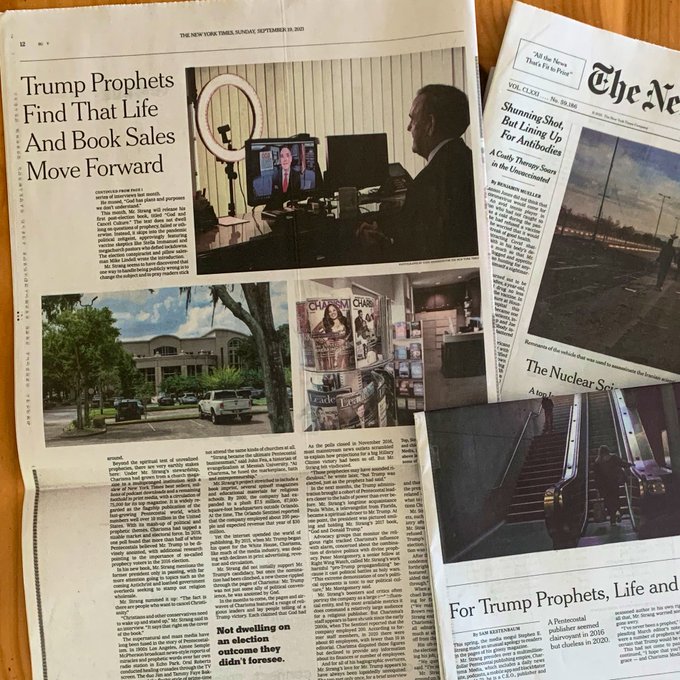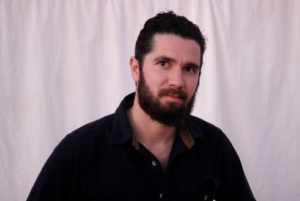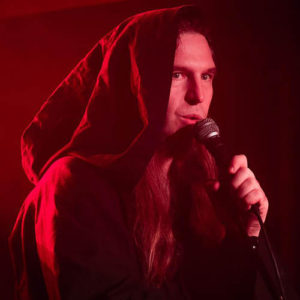Insights from a Religion Reporter
An interview with award-winning journalist Sam Kestenbaum about what he has learned covering religion in America

(Photo courtesy of Sam Kestenbaum’s Twitter account)
Sam Kestenbaum is a too-rare thing these days: a religion reporter. There was once a time when most newspapers — national and local — had writers on the religion beat, but as bureaus shrank and publications shuttered, fewer papers and websites regularly published stories by journalists who, like Kestenbaum, have a practiced subject expertise. Of course, that doesn’t mean religion isn’t in the news. But it does mean that news writers don’t approach religion stories with the same nuance or historical perspective as a specialist.
Kestenbaum writes regularly about religion for the New York Times and other publications, and his work has been honored with several prestigious awards. I’ve followed his writing for a number of years. He has a particular talent for telling stories about complicated people with a kind of lucid nuance — taking them seriously without entirely taking them at their word. Not incidentally, that means he is also especially well-attuned to the relationship between religion and media in these stories, both how the media engages with figures and groups and how those groups engage with, and produce, their own media.
While religion is frequently in the news, I thought this month — one year out from the last U.S. presidential election and still very much in the midst of the pandemic — would be an especially good time to talk to Kestenbaum about what it’s like to cover religion in the United States, to try to get a sense of what makes for incisive religion reporting, and to glean what he has learned from his years of writing about religion in America.
Kali Handelman: Can you tell me about what drew you to the subject of religion and what’s kept you interested in it?

(Photo from Sam Kestenbaum’s website)
Sam Kestenbaum: There are a couple of ways to narrate that. The personal story: I grew up on a teeny island in Maine and was one of the only Jews there. I suspect this made me aware, as a young guy, of religious borders and what it feels like to move around and between them. (The first story I ever wrote for the New York Times was about this, actually.)
I spent several years doing journalism overseas, mostly in the Middle East, before returning to New York and focusing on domestic issues. As a writer, I’ve found religion to be an expansive and colorful and thorny subject, one way to try to understand America, and something I could be curious about professionally. I’ve been fortunate to make some sort of career doing that.
KH: That makes a lot of sense — and as a fellow rural New England Jew who chose to make a home in New York City, I can identify with that. I definitely see the curiosity you mention in how you approach New York, finding the far-flung and esoteric especially compelling, which makes me want to know how you do research for your stories. When you’re getting started on a new story, where do you go to start learning about a tradition or community you’re interested in?
SK: I’m going to say a bit about how I generate ideas and view journalism, as I think this might give a window into my process. It boils down to two things: studying the old stuff and hanging around interesting places and people. First, I find it really useful to see how journalists have seen and written about religion over time. Here, I’m looking not just at the raw content of their reporting, so to speak, but also tracking the shifting style, voice, and priorities of periodicals. I’m talking about things like old 1900s penny-press and broadsheets; lurid tabloids from the ’50s (I collect old National Enquirer copies); or zines and alt-weeklies from the ’90s. There’s such fun and punchy copy here, and so many great phrases to crib on just the level of language. Other sorts of questions I’m asking as I read: What type of religion gets approvingly written about, and what’s suspicious? What gets flashy cover treatment, and what’s tucked into the back page? What’s of interest in what time period, and why? As a journalist working on religion in America I see all of this material as an inheritance of sorts, something to contend with and draw from.
With all those historical echoes in mind I go out into the field and find the living people doing religion right now. I’m an evangelist for what journalist Gay Talese called the “art of hanging out,” and a longstanding practice of mine has been to drop in on churches, synagogues, temples, or tabernacles — attending backyard revivals, mega-congregations and anything in between. For a time, I would go to a new spot each week in New York City and meet Moors, Hebrew Israelites, Pentecostals, Hasidim, New Thoughters, Theosophists, whatever. I wouldn’t burst in as a reporter working on a story — though I would identify myself — but as a visitor. This would put people at (some) ease, plus give me the space to soak it all in.
If I felt there was some germ of a story to cultivate I would return, sometimes much later, notepad in hand. For example, one week I stumbled on a small storefront church in Brooklyn where the lead pastor, originally a Christian, was in the middle of adopting a long-forgotten 19th-century Spiritualist bible called the Oahspe, a unique kind of proto-sci-fi scripture chock full of things like lost continents and star ships. I would later write about the church’s metamorphosis for the Metropolitan section of the New York Times, but it all started with happening upon them that one weekend.
KH: I’d love to hear more about that process of “studying the old stuff.” It’s clearly not just part of your research, but also what you include in your stories. Why do you think it’s important to add this kind of historical context to your articles?
SK: It’s not something I want to pound over the reader’s head, but those historical echoes — if not exactly full blown genealogies — are something I try to layer into feature writing. Just as I reflect on my own reporter’s inheritance — those zines and tabs — I also think about my subjects in terms of the past. It can be a delicate thing. I want to show that there are always antecedents, but do this without undercutting the now-ness of the subject, or sounding snooty or condescending to readers. This means exploring what feels novel about, say, Pentecostal media mogul Stephen Strang promoting Trump prophecies, as well as showing the important history to unspool there. With that feature specifically I knew I wanted to place Strang and his company, Charisma Media, within a lineage of American Pentecostals working with media and blending earthly enterprise and eye-popping supernatural content. This meant I found myself revisiting not just old reporting on Pentecostals, but the media they produced themselves: pages of Aimee Semple McPherson’s newspapers she put out (they’re all digitized); old clips of Jim and Tammy Faye Bakker’s shows; or watching Oral Roberts healing through the TV screen (YouTube is a treasure). Pointing to this heritage shouldn’t overwhelm or take away from the novelty of the overall Charisma Media story, but add a deeper resonance.
KH: Your work is consistently interested in what academics would mostly call New Religious Movements. You’ve also done a lot of writing about groups at the fringy-ier end of that spectrum, including some groups that have been called “cults” as well as the seers and prophets who lead them. What interests you about these communities, traditions, and practices? How do you approach new people respectfully?
SK: I often write about those religious groups or people that are seen as going against the grain, a little outré or maybe beyond some respectable bounds. What draws me to those sorts of subjects is this: I want to see, up close, how they do it, how they cultivate their intriguing image. What I mean is, would-be outsider groups can be experts at building their brands — playing up and into the theatrical, controversial, exotic, or zany. I don’t see anything haphazard here, but strategy — and, yes, that can apply to those groups called cults.

(Father Sebastiaan. Photo credit: Witch Con)
The credo in some circles, I know, is that “cult” is a straightforward pejorative that has no responsible use. But I’m struck by the number of times I’ve seen groups lean into the cult-y brand. As just one example: There was a self-styled vampire guru I spent time with as part of a feature for the Times. This fellow — his real name was Todd but he called himself Father Sebastiaan — was part forty-something one-time party kid, part religious entrepreneur, and had once presided over big occult bacchanals in downtown Manhattan. (They would do things like drag a coffin out onto the dance floor; it’s said people were drinking blood in kinky back rooms.) He and I spent time in his dim, cramped studio where he personally sculpted removable fangs into the mouths of customers who, once the teeth had been fitted, would recite an oath to his vampire clan. Was it foreboding ritual? Edgy joke or performance art? He would then, maybe with a fanged smile, boast that he was a kind of cult leader, growing his cult fandom person by person. I think those interactions offer a reminder that the brand of outsider is one that’s on offer — and sells! — on the market. I can’t say exactly how I manage to ingratiate myself to people like Father Sebastiaan, but I try to convey to folks that I’m interested in what they do and how they do it… and who doesn’t like talking about themselves?
KH: Most of these pieces are, in part, profiles. What is it about the individual leaders — Keano, Father Sebastiaan, Ryuho Okawa, Jonathan Cahn, Marianne Williamson — that interests you?
SK: I find that the character studies, looking at the people at the heart of these stories, are an interesting way to get at some of those dynamics I just mentioned. This doesn’t mean that I take religious leaders to be representative of movements, exactly, but that biography — and particularly the newspaper profile — is an interesting form to play with as a writer.
What’s appealing, I think, about individual portraits is that they give a way to show that people are always messy — revealing some things, hiding others, a jumble of the good, the ugly, foibles, hopes, aspirations, strategic choices, mercurial motivations. Exploring that, putting the lens tightly on the individual, can illuminate something about the religious, social, or professional worlds they inhabit, but it strikes me as a subtler way to back into those wider topics.
KH: Some of your recent work engages with electoral politics and current events, such as the Covid-19 pandemic. Your approach — focus on particular figures and organizations — offers something different to these frontpage subjects. What do you want readers to understand about the role of religion in American politics?
SK: There’s this idea, in the law and public, that religion and politics are disparate types of power that can (or ought to) be neatly untangled from each other. The anxiety about what happens when the two meet is what’s interesting to me, and how different people define each.
This past year I’ve spent a lot of time in anti-mask, anti-lockdown churches or gatherings in California, where pastors and leaders were making dramatic proclamations against state mandates or advocating for Gavin Newsom’s recall election — pretty political stuff, by most accounts. At the same time, I’ve had conversations with people in those same venues who tell me they’ve left their previous, more liberal congregations because they felt the churches had gone astray by approvingly preaching about things like Black Lives Matter, and took this, in their words, to be too political. We can agree or disagree with the assessment, sure, but what gets called politics and what gets called religion, and by whom, is worth paying attention to. The people I’m looking at, I think, highlight these ambiguities.
KH: Lastly, as we both know, there aren’t that many writers who are able to make religion their beat these days, which means that a lot of people wind up writing about religion whether or not they have any particular background or interest in the subject. Are there things you wish other writers would do more (or less) of in their writing about religion?
SK: I think often about the mantra: “The media doesn’t get religion.” Journalist Dean Baquet said this after Donald Trump’s upset victory; there’s the “Get Religion” commentary website co-founded by writer Terry Mattingly; versions of the same mantra are evoked in academic interventions, or by religious literacy advocates. But what does this mean to get religion? Do any of these people have a shared definition? Sometimes it seems like it’s about elevating particular theologies as representative, sometimes it means giving a platform to one group over the other, talking to not just experts but the right experts, and on and on.
What’s more, the idea that religious actors need the media to get them, in any fashion, is curious to me. Because I’m struck over and over by how religious people and groups are themselves media-makers, often really good media-makers. I mean, like, have you watched Sid Roth’s miracle reenactments? The 700 Club? Seen Sean Feucht work the crowd? Mennonites on TikTok? Hay House has had so many hits! These are not people sitting around in some backwater faraway place waiting for us to faithfully reproduce their never-before-seen image. They’re telling their own stories, expertly, and we’re the ones catching up. Marianne Williamson is an author and self-help star; Jonathan Cahn is a bestselling author of prophecy books; Ryuho Okawa’s Happy Science is an anime-and-book powerhouse. I might be covering these people, but they’re savvy content creators themselves, credit where it’s due.
So, we can think about how the media does or doesn’t get religion, whatever this means, yes! But I’m most interested in — if I may turn it — how religion “gets” media.
Kali Handelman is an academic editor based in London. She is also the Manager of Program Development and London Regional Director at the Brooklyn Institute for Social Research and a Contributing Editor at the Revealer.
Sam Kestenbaum is a religion reporter who contributes to the New York Times. His work has won the Rockower Award for Excellence in Feature Writing and prizes from the Silurians Press Club and Society for Features Journalism.